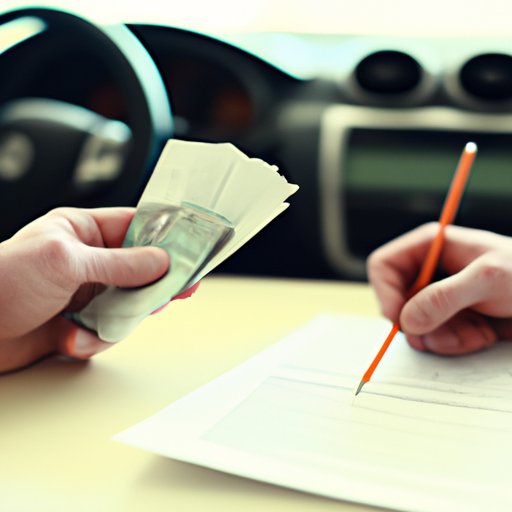Introduction
If you’re looking to upgrade your current vehicle, trading in a car you are financing is an option worth considering. Trading in a car when you are still making payments on it can be a complicated process, but with the right knowledge and preparation, it can be a relatively simple and straightforward one. This article will provide a comprehensive guide on how to trade in a car that you are financing.

Definition of Trading In a Car You Are Financing
Trading in a car you are financing refers to selling your current car to a dealership as part of a deal to purchase a new car. The dealership will use the equity of your current car to offset some of the cost of the new car purchase. This can be a great way to save money if you are looking to upgrade your car without having to pay off the full balance of your current car loan.
Overview of the Process
The process of trading in a car you are financing involves several steps, including researching the market value of your car, checking your loan status, preparing the necessary documents, comparing offers, and negotiating for the best price. Let’s take a closer look at each of these steps.
Researching Market Value of Your Car
Before you can begin the process of trading in your car, it is important to research the market value of your car so that you know what to expect from potential offers. There are a few factors to consider when researching the market value of your car, such as the make, model, year, mileage, condition, and any additional features or upgrades. It is also important to keep in mind that the market value of your car may be different in different regions.
There are a few sources you can use to research the market value of your car, such as Kelley Blue Book, Edmunds, and NADA Guides. These sources are all online and provide estimates of the market value of a variety of cars, based on the criteria you enter. Additionally, you can check classified listings in your area to get an idea of the current prices of similar cars.
Checking Loan Status
Once you have an estimate of the market value of your car, you can start to explore the possibility of trading in your car. Before you do so, however, it is important to check the status of your loan. If your loan is not yet paid off, you will need to take some additional steps before you can trade in your car.
For example, you will need to calculate any early termination fees that you may incur by paying off the loan early. Additionally, you will need to factor in any additional fees associated with transferring the loan to a different lender. It is important to do your research and understand all fees associated with trading in a car you are financing so that you can accurately assess the cost of the trade-in.
Preparing Documents
In order to trade in a car you are financing, you will need to have certain documents on hand. These documents include the title of the car, proof of insurance, and the loan paperwork. You will also need to provide any other documents requested by the dealership, such as a driver’s license and proof of address.
You can obtain the necessary documents from your lender or insurance company. If you are unable to get the documents from them, you can contact the DMV in your state for assistance. Make sure to have all of the required documents on hand before you go to the dealership.
Comparing Offers
Once you have the necessary documents, it is time to start comparing offers. Shopping around for the best offer can help you get the most out of your trade-in. Be sure to compare offers from multiple dealerships to ensure that you get the best possible deal. Additionally, don’t forget to factor in any incentives or discounts that may be available.
You can find offers from local dealerships by visiting their websites or calling them directly. You can also use online resources such as CarGurus or Autotrader to compare offers from multiple dealerships at once. Keep in mind that the offers you receive may vary depending on the region and time of year.
Negotiating for Best Price
Once you have compared offers, it is time to start negotiating for the best price. When negotiating, it is important to be patient and persistent. Don’t be afraid to ask questions and push for a better deal. Additionally, it can be helpful to bring along a friend or family member who can help you stay focused and confident during the negotiation process.
When negotiating, it can be helpful to break down the total cost of the trade-in into smaller parts. For example, you can negotiate the trade-in value of your car separately from the price of the new car. Additionally, you can try to negotiate for extras or incentives, such as free maintenance or extended warranties. By breaking down the negotiation into smaller parts, you can increase your chances of getting the best possible deal.
Conclusion
Trading in a car you are financing can be a great way to upgrade your car without having to pay off the full balance of your loan. By following the steps outlined in this article, you can ensure that you get the best possible deal. Research the market value of your car, check your loan status, prepare the necessary documents, compare offers, and negotiate for the best price. With the right knowledge and preparation, trading in a car you are financing can be a simple and straightforward process.
(Note: Is this article not meeting your expectations? Do you have knowledge or insights to share? Unlock new opportunities and expand your reach by joining our authors team. Click Registration to join us and share your expertise with our readers.)
